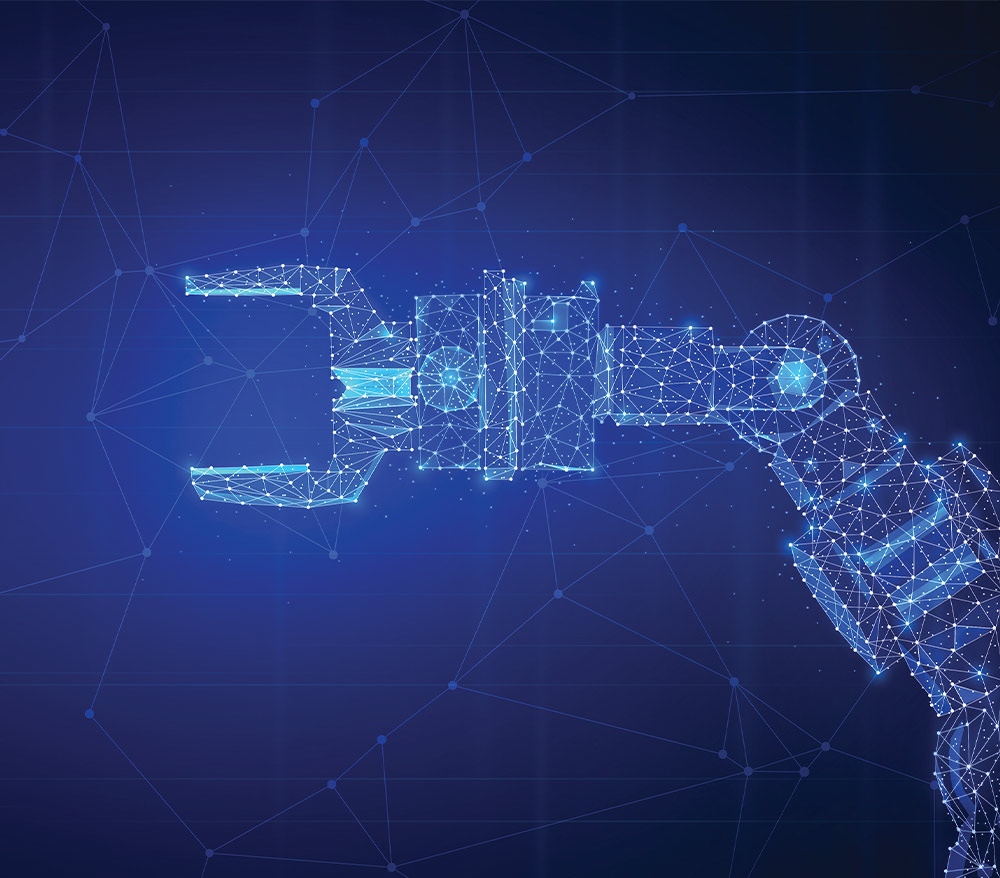
obotics is a rapidly growing field with applications in multiple industries and taking many shapes and forms in today’s world. Examples include collaborative robots (cobots), industrial mobile robots (IMRs), automatic guided vehicles (AGVs), automated mobile platforms (AMPs), smart mining, autonomous mobile storage for the retail industry, medical robots, and robotic personal assistants.
As these devices become more prevalent, it is important to understand the hazards and testing options for these innovative devices, as well as the various global standards and requirements with which manufacturers and developers will need to comply.
There are several hazards that need to be assessed and addressed for robots and robotic devices. The main hazards to consider for robotics are:
- Mechanical: Hazards originating from moving, overspeed, falling, sharp edges, etc., that are caused by the design and function of the system itself must be considered and assessed.
- Electrical: The overall safety and performance of electrical components, including insulation, thermal effect, and shock hazard within the device and its peripherals should be considered, particularly in regard to electrical safety standards.
- Ergonomic: These are potential ergonomic concerns related to the design and comfort of the device or system.
- Thermal: Products must be assessed for the potential to overheat, which could result in fire/explosion, burns, or other damage.
- Acoustical/Noise: Operational issues resulting in unwanted or loud noises could arise as a product performs its intended task or function.
- Vibration: Mechanical issues that lead to unwanted or excessive vibration during use. This, in turn, can produce noise and potential damage to the product.
- Radiation: Electromagnetic emissions from the system and its components must fall within a range that is considered safe and acceptable.
- Material/substance: Hazards related to the components within the robot, such as wiring, metals, liquid, etc., must be considered and assessed.
- Environmental: Hazards associated with the specific environment related to the machine’s intended use. For example, in a healthcare environment, potential interference hazards associated with other medical devices and their critical functions.
In addition to individual hazards, it is common to see combinations of hazards, such as vibration and noise (vibration issues will create concerns around noise), electrical and thermal (poor electrical quality leading to overheating), or chemical and radiation. It is important to keep these potential combinations in mind when developing products, so you can mitigate risk in the product design and test appropriately when assessing the device.

To assess the hazards associated with robotics, there are several testing areas that may apply. Depending on the hazard(s), you will need to consider:
- Hazardous locations assessments: Products used in hazardous locations or explosive atmospheres must be assessed to specific, stringent requirements in place for these environments.
- Functional safety evaluation: To ensure a device’s fail‑safe mechanisms are operating correctly and risks are reduced to as low as reasonably predictable, these assessments are vital to qualify or quantify the safety integrity level of safety functions.
- Process evaluations: This may include things like risk management, programmable electrical medical systems, and usability. Process assessments will depend on the individual products, their intended use, and potential environments.
- Mechanical safety testing: These are evaluations that assess machinery and mechanics for performance and safety. These tests should assess potential risks and may also identify some that must be prevented and/or corrected.
- Electrical safety testing: These assessments will help to ensure safe operating standards in relation to the product’s use of electricity. They also illustrate compliance with electrical safety standards required in a given market.
- Performance testing: Assesses attachments like manipulators, visual detection, and acoustical devices for overall performance and endurance to ensure consistency with use.
- Environmental testing: Assessing hazards related to the intended environment to ensure product performance and safety is important. Products used outdoors, for example, will need to be evaluated for components like weather and climate concerns. Products used in industrial settings will need higher endurance factors than those used in homes.
- Electromagnetic compatibility (EMC) & electromagnetic interference (EMI): These tests help to ensure a product continues to function when in use around other devices emitting electromagnetic energy, as well as making sure that a device does not interfere with the operations and function of other nearby products. As more products in use emit EMI, these assessments are increasingly important.
- Wireless and cybersecurity testing: Ensure wireless products meet requirements for connectivity, function, and data protection. As the world becomes more connected, it is more important than ever to ensure the security of any product.
In addition to understanding potential hazards and testing options, it is critical to know the standards for robots applicable in the region or market in which a device will be marketed or sold. Often these standards address all or some of the hazards identified and outline testing requirements as well. What is required does vary by market, however, so it’s important to know which standards apply to a given project.
A global standard, ISO 10218‑1: Robots and robotic devices, addresses the safety requirements for industrial robots, systems, and integration. This ISO standard has been harmonized and adopted by many countries and regions; however, there are other standards that may apply to robotics in a given area.

Robots in the European Union (EU) are regulated based on their application. Industrial robots fall into the scope of the Machinery and EMC Directives. Manufacturers should follow existing EN and ISO standards on robotic devices. Several of these standards are harmonized under the Machinery Directive and include the following:
- EN 12100: Safety of machinery – General principles for design – Risk assessment and risk reduction
- ISO 13849‑1: Safety of machinery – Safety related parts of control systems Part 1: General principles for design
- EN ISO 10218‑1: Robots and robotic devices – Safety requirements for industrial robots
- EN ISO 10218‑2: Robots and robotic devices – Safety requirements for industrial robots; robot systems and integration
- EN ISO 13482: Robots and robotic devices – Safety requirements for personal care robots
- ISO/TS 15066: Robots and robotic devices – Collaborative robots
- EN 61000‑6‑2: Electromagnetic compatibility (EMC) Part 6‑2: Generic standards – Immunity standard for industrial environments
- EN 61000‑6‑4: Electromagnetic compatibility (EMC) Part 6‑4: Generic standards – Emission standard for industrial environments
- ISO 9283:1998: Manipulating industrial robots – Performance criteria and related test methods
- ISO 13850: Safety of machinery – Emergency stop – Principles for design
- IEC 60204‑1: Safety of machinery – Electrical equipment of machines – Part 1: General requirements
- IEC 62061:2005: Safety of machinery – Functional safety of safety‑related electrical, electronic and programmable electronic control systems
- EN 1525: Safety of industrial trucks. Driverless trucks and their systems
- EN1526: Safety of industrial trucks. Additional requirements for automated functions on trucks
- ISO 3691‑4: Driverless industrial trucks and their systems
In the EU, medical robots must adhere to IEC 60601‑1 ED3+AMD1. This general standard must be applied in conjunction with new standards in development, such as:
- IEC 80601‑2‑77: Particular requirements for the basic safety and essential performance of robotically assisted surgical equipment
- IEC 80601‑2‑78: Particular requirements for the basic safety and essential performance of medical robots for rehabilitation, assessment, compensation or alleviation
For robots used in hazardous locations or potentially explosive environments, the ATEX Directive, 2014/34/EU must be considered. If the safety of machinery is governed by safety distance, then EN 13857 applies. Other machinery standards may also be applicable. Finally, some robots will need to comply with the EU’s Radio Equipment Directive (RED), 2014/53/EU, which establishes safety and EMC requirements for equipment using the radio spectrum.
A series of standards have been developed for the North American market, which, together with existing international standards, ensure a high degree of safety evaluation.
- ANSI/RIA R15.06: American national standard for industrial robots and robot systems safety requirements (originated from ISO 10218 series)
- ANSI/RIA R15.08: Mobile Robot Safety (in development)
- ANSI/UL 1740: Standard for robots and robotic equipment
- CAN/CSA Z434: Industrial robots and robot systems (originated from ISO 10218 series)
- ISO 10218‑1: Robots and robotic devices – Safety requirements for industrial robots
- ISO 10218‑2: Robots and robotic devices – Safety requirements for industrial robots; robot systems and integration
- ISO 13849‑1: Safety of machinery – Safety related parts of control systems Part 1: General principles for design
- ISO 13482: Robots and robotic devices – Safety requirements for personal care robots
- IEC 61508‑1: Functional safety of electrical/ electronic/ programmable electronic safety‑related systems; Part 1: General requirements
- IEC 61508‑2: Functional safety of electrical/electronic/programmable electronic safety‑related systems. Part 2: Requirements for electrical/electronic/programmable electronic safety‑related systems
- IEC 61508‑3: Functional safety of electrical/electronic/programmable electronic safety‑related systems. Part 3: Requirements for software.
- IEC 62061: Safety of machinery – Functional safety of safety‑related electrical, electronic and programmable electronic control systems
- UL 3100: Outline of Investigation for Automated Mobile Platforms (AMPs)
In Asia, many countries have standards for robots that are harmonized with ISO 10218‑1. There are also some standards to address risk management, in addition to standards for general electrical safety. Here are some examples of Asian robotics standards:
- GB 11291: Robots and robotic devices. Safety requirements for industrial robots
- GB 11291.2‑2013: Robots and robotic devices. Safety requirements for industrial robots. Part 2: Robot systems and integration
- GB/T 15706‑2012: Safety of machinery. General principles for design. Risk assessment and risk reduction
Japan
- JIS B9700:2013: Safety of Machinery – General Principles for Design – Risk assessment and risk reduction
- JIS 8433‑1: Robots and robotic devices – Safety requirements for industrial robots Part 1
- JIS TS B0033: Robots and robotic devices – Collaborative robots
South Korea
- KS B ISO 10218‑1: Robots and robotic devices – Safety requirements for industrial robots
- KS B ISO 10218‑2: Robots and robotic devices – Safety requirements for industrial robots – Part 2: Robot systems and integration
Taiwan
- CNS 14490‑1 B8013‑1: Robots and robotic devices – Safety requirements for industrial robots – Part 1: Robots and robotic devices
- CNS 14490‑2 B8013‑2 Robots and Robotics – Safety Requirements for Industrial Robots – Part 2: Robot Systems and Whole Combined
Singapore
- SS ISO 10218‑1:2016: Robots and robotic devices – Safety requirements for industrial robots
- SS ISO 10218‑2:2016: Robots and robotic devices – Safety requirements for industrial robots – Part 2: Robot systems and integration
As the use and prevalence of robots continue to evolve, manufacturers and developers can prepare their products for various markets in several ways. First, it is important to know the standards and requirements for the market you are looking to enter. Along these lines, stay informed on updates and changes in each market, which are inevitable in a rapidly changing field. Additionally, keep up‑to‑date on changes in technology and its applications, as they may impact standards and requirements.
Identify any overlaps in the testing and assessment requirements of the market(s) you wish to enter. This may help streamline your approach, which, in turn, can get products to market more quickly and at a reduced cost.
Work with a trusted and knowledgeable partner who knows the standards and the best ways to illustrate compliance. Such a partner can help to build a comprehensive test plan to get products to market, one that includes assessments for quality and safety to help ensure a product’s success.
Robots and robotics offer many possibilities to so many different industries, and many manufacturers wish to explore the opportunities with these products. Knowledge of the standards and requirements can not only ensure a safer, better performing product, it can allow you to get your products to market quickly and efficiently.
